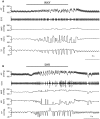Cardiovascular responses induced by obstructive apnea are enhanced in hypertensive rats due to enhanced chemoreceptor responsivity
- PMID: 24466272
- PMCID: PMC3900660
- DOI: 10.1371/journal.pone.0086868
Cardiovascular responses induced by obstructive apnea are enhanced in hypertensive rats due to enhanced chemoreceptor responsivity
Abstract
Spontaneously hypertensive rats (SHR), like patients with sleep apnea, have hypertension, increased sympathetic activity, and increased chemoreceptor drive. We investigated the role of carotid chemoreceptors in cardiovascular responses induced by obstructive apnea in awake SHR. A tracheal balloon and vascular cannulas were implanted, and a week later, apneas of 15 s each were induced. The effects of apnea were more pronounced in SHR than in control rats (Wistar Kyoto; WKY). Blood pressure increased by 57±3 mmHg during apnea in SHR and by 28±3 mmHg in WKY (p<0.05, n = 14/13). The respiratory effort increased by 53±6 mmHg in SHR and by 34±5 mmHg in WKY. The heart rate fell by 209±19 bpm in SHR and by 155±16 bpm in WKY. The carotid chemoreceptors were then inactivated by the ligation of the carotid body artery, and apneas were induced two days later. The inactivation of chemoreceptors reduced the responses to apnea and abolished the difference between SHR and controls. The apnea-induced hypertension was 11±4 mmHg in SHR and 8±4 mmHg in WKY. The respiratory effort was 15±2 mmHg in SHR and 15±2 mmHg in WKY. The heart rate fell 63±18 bpm in SHR and 52±14 bpm in WKY. Similarly, when the chemoreceptors were unloaded by the administration of 100% oxygen, the responses to apnea were reduced. In conclusion, arterial chemoreceptors contribute to the responses induced by apnea in both strains, but they are more important in SHR and account for the exaggerated responses of this strain to apnea.
Conflict of interest statement
Figures







References
-
- Fletcher EC, Lesske J, Behm R, Miller CC 3rd, Stauss H, et al. (1992) Carotid chemoreceptors, systemic blood pressure, and chronic episodic hypoxia mimicking sleep apnea. J Appl Physiol 72: 1978–1984. - PubMed
-
- Narkiewicz K, Van de Borne PJH, Montano N, Dyken ME, Phillips BG, et al. (1998) Contribution of tonic chemoreflex activation to sympathetic activity and blood pressure in patients with obstructive sleep apnea. Circulation 97: 943–945. - PubMed
-
- Somers VK, Mark AL, Abboud FM (1988) Potentiation of sympathetic nerve responses to hypoxia in borderline hypertensive subjects. Hypertension 11: 608–612. - PubMed
-
- Trzebski A, Tafil M, Zoltowski M, Przybylski J (1992) Increased sensitivity of the arterial chemoreceptor drive in young men with mild hypertension. Cardiovasc Res 16: 163–172. - PubMed
Publication types
MeSH terms
Substances
LinkOut - more resources
Full Text Sources
Other Literature Sources
Medical

